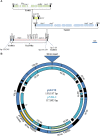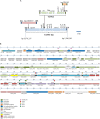Spread of Carbapenem Resistance by Transposition and Conjugation Among Pseudomonas aeruginosa
- PMID: 30233535
- PMCID: PMC6133989
- DOI: 10.3389/fmicb.2018.02057
Spread of Carbapenem Resistance by Transposition and Conjugation Among Pseudomonas aeruginosa
Abstract
The emergence of carbapenem-resistant Pseudomonas aeruginosa represents a worldwide problem. To understand the carbapenem-resistance mechanisms and their spreading among P. aeruginosa strains, whole genome sequences were determined of two extensively drug-resistant strains that are endemic in Dutch hospitals. Strain Carb01 63 is of O-antigen serotype O12 and of sequence type ST111, whilst S04 90 is a serotype O11 strain of ST446. Both strains carry a gene for metallo-β-lactamase VIM-2 flanked by two aacA29 genes encoding aminoglycoside acetyltransferases on a class 1 integron. The integron is located on the chromosome in strain Carb01 63 and on a plasmid in strain S04 90. The backbone of the 159-kb plasmid, designated pS04 90, is similar to a previously described plasmid, pND6-2, from Pseudomonas putida. Analysis of the context of the integron showed that it is present in both strains on a ∼30-kb mosaic DNA segment composed of four different transposons that can presumably act together as a novel, active, composite transposon. Apart from the presence of a 1237-bp insertion sequence element in the composite transposon on pS04 90, these transposons show > 99% sequence identity indicating that transposition between plasmid and chromosome could have occurred only very recently. The pS04 90 plasmid could be transferred by conjugation to a susceptible P. aeruginosa strain. A second class 1 integron containing a gene for a CARB-2 β-lactamase flanked by an aacA4'-8 and an aadA2 gene, encoding an aminoglycoside acetyltransferase and adenylyltransferase, respectively, was present only in strain Carb01 63. This integron is located also on a composite transposon that is inserted in an integrative and conjugative element on the chromosome. Additionally, this strain contains a frameshift mutation in the oprD gene encoding a porin involved in the transport of carbapenems across the outer membrane. Together, the results demonstrate that integron-encoded carbapenem and carbapenicillin resistance can easily be disseminated by transposition and conjugation among Pseudomonas aeruginosa strains.
Keywords: Pseudomonas aeruginosa; VIM-2; carbapenem resistance; conjugation; genome sequence; integrative and conjugative element; integron; transposon.
Figures



References
LinkOut - more resources
Full Text Sources
Other Literature Sources
Miscellaneous

